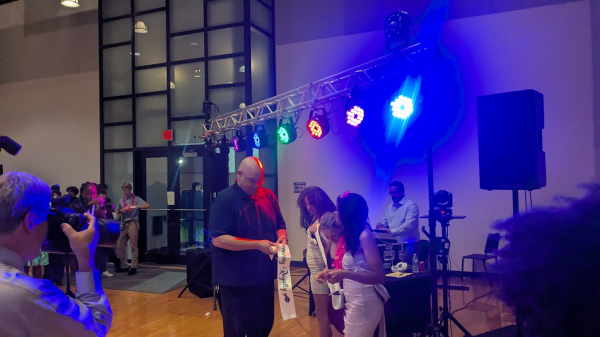Remembering Lata Mangeshkar
The iconic Bollywood singer paved the way for female artists to assert control of their own careers

Image source: bollywoodhungama.com via WikimediaCommons
Lata Mangeshkar pictured at her birthday concert in 2011.
Lata Mangeshkar was an eight-decade Indian cultural phenomenon who launched her singing career at age 13 and continued it until her death at the age of 92 on Feb. 6 of this year.
Mangeshkar was well known for her incredible range, intense work ethic, and for her ability to push back when music industry leaders tried to limit her. Her dedication, kindness and honesty earned her the appreciation of the Bollywood music industry and the Indian people.
Lata Mangeshkar’s most recent work includes songs like “Lukka Chuppi” from the 2006 Bollywood movie Rang De Basanti, a duet with Sonu Nigam in “Kyun Hawa” from 2004’s Veer-Zaara, a duet with Sonu Nigam in the title track for the 2001 movie Kabhi Khushi Kabhie Gham, a solo in “Daata Sun Le” for the 2009 movie Jail and many, many more.
Over the course of her career she sang over 25,000 songs in multiple languages and earned a place in the Guiness book of world records for doing so. She also established women as a more powerful force in the Bollywood music industry, and effectively balanced the typically producer-favoring artist-producer dynamic.
Her work, including major hit songs such as “Dil Mera Toda, Mujhe Kahin Ka Na Chhora”, “Lag Jaa Gale” and “Aayega Aanewala”, has earned her nicknames like, “the Queen of Melody”, “Nightingale of India” and “Voice of the Millenium”. Her greatest achievement, the same achievement she is most known for today, was earning in 2001 the Bharat Ratna, the highest honor the Indian government can bestow upon a civilian.
Mangeshkar was born in Indore, India to Shevanti and Dinanath Mangeshkar on Sept. 28, 1929. Dinanath, who was the owner of a music theater and a well-respected singer of his time, noticed his daughter’s talent early in her life and started training her accordingly. At just five years old, Lata was given singing lessons by her father, and given opportunities to study world class singers of the era such as Amanat Khan and Aman Ali Khan Sahib.
Unfortunately, though, Lata’s father died in 1942, leaving thirteen-year-old Lata Mangeshkar with the burden of providing for her grieving family. Pitying the situation, a friend of her father and respected Bollywood actor in his own right, Vinayak Damodar Karnataki, decided to take the Mangeshkar family under his wing, even offering Lata a role in the film Badi Maa.
Thanks to opportunities like this one, Lata was able to meet industry titans and eventually make her way into the music industry. In 1949 she moved to Mumbai to continue her education in Hindi music under the famed artist Ustad Aman Ali Khan.
This is when Lata’s serious career began. Because she naturally sang in an extremely high pitched voice, a clear juxtaposition from popular Bollywood singers of the time who sung in heavy and nasal voices, and because her vocal range was far beyond just impressive, she became an ideal candidate for great music composers trying to experiment with new ideas or with difficult songs, making her an industry favorite.
At the same time that her sister, Asha Bhosle, was rising to fame for her own unique singing talents, Lata had become a music industry sensation so great that people, perhaps for the first time in Bollywood history, began caring about the artists behind the songs they enjoyed just as much as they cared about the actors in the movies they watched.
With her rise to fame, though, came informal conflict between the producers of her music and herself. The typically producer-favoring power dynamic had changed now that Lata was so sought after, and despite their best attempts to monopolize her sound, Lata’s headstrong and assertive personality prevented them from regaining ground. Sumit Mitra, writing for the India Today Magazine, summarized it best with a quote from an industry leader that read, “Some of us treated Lata like our exclusive property. We sought to dominate her, overshadow her, browbeat her. Maybe we were upset as she began paying us back in our own coin.”
Despite the conflicts she had to face, though, Lata remained well known for being cool-headed and kind. In her eighty-year career, she has had very few significant public disputes with other artists, a demonstration of self restraint when compared to the constant media fights between both Indian and American public figures that we see today. For her kindness, skill and impact on the Bollywood music industry, Lata earned the respect of her peers and that of a vast majority of the Indian population.
When asked about Lata Mangeshkar’s public personality and impact, my mother Somali Ghosh, who grew up in India and has heard Lata’s voice in songs and in Bollywood movies since childhood, responded enthusiastically.
“Lata Mangeshkar is truly India’s nightingale, her evergreen voice transcended several decades of Indian cinema,” she said.
My father Yogesh Makkar, who also grew up in India listening to Lata’s music, responded similarly.
“She sang in so many Indian languages, she seemed to transform music into a language of its own,” he said.
From public response, the positive impact Lata Mangeshkar has left is obvious in the wake of her death.
Though she didn’t intend to be, Lata Mangeshkar ended up becoming an early feminist icon who simultaneously established a place for independent female singers and acted as a role model for young women all over India.
No matter what difficulty or conflict came her way, she found a way to balance kindness and calm with stubbornness and strength.
The status of women has changed for the better around the world in the last eighty years, and it is largely thanks to the work and influence of role models like Lata Mangeshkar that such change has been possible.
Although Women’s History Month has come to an end, it is important to remember people like Lata who were not only crazy enough to take on the world, but who also changed it for the better.

Sanket Makkar began writing for the Beachcomber in the fall of 2021. He is interested in covering Bollywood cinema and emerging technologies with a potentially...












